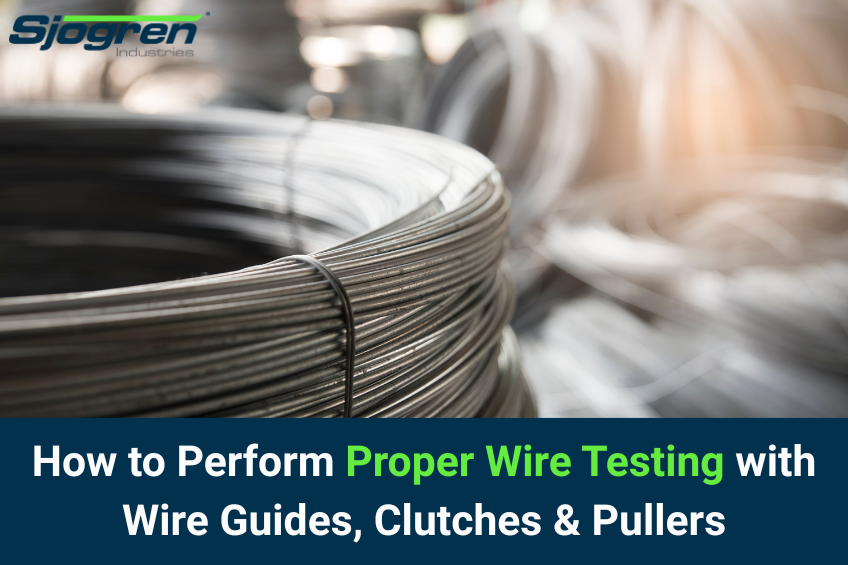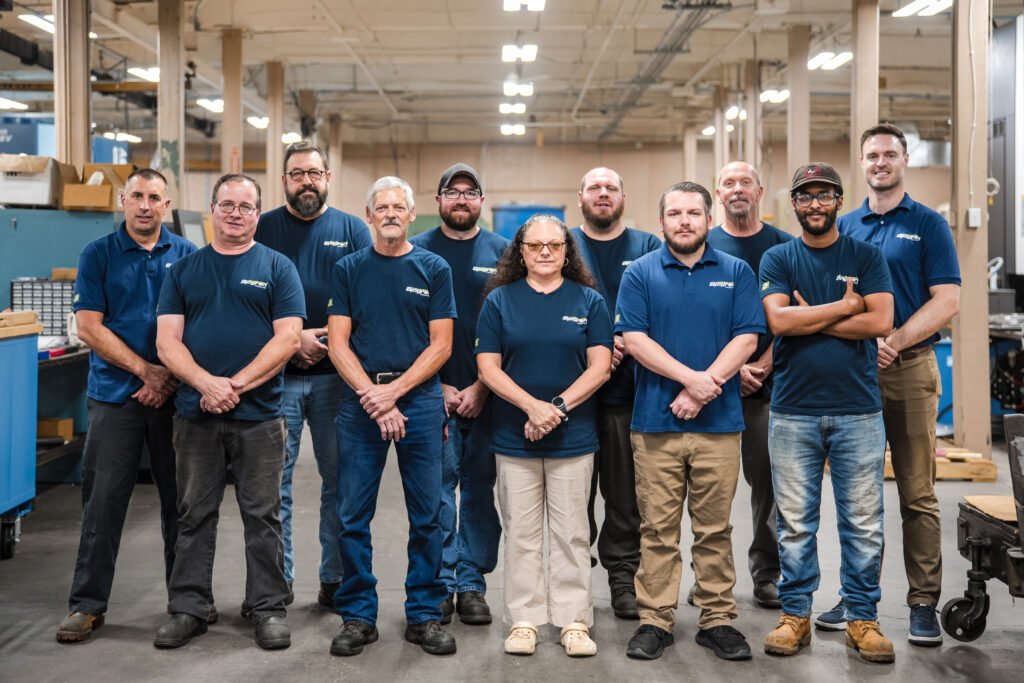How to Perform Proper Wire Testing with Wire Guides, Clutches, and Pullers

Reliable wire testing is the backbone of quality, safety, and compliance. If the test setup isn’t sound, results drift, decisions stall, and production costs climb. Accuracy depends on more than the testing machine—it hinges on the path the specimen travels, the tension applied, and the integrity of the grip. That’s where the right support gear earns its keep.
Proper wire guides protect surfaces and keep alignment true. Stable torque control prevents spikes that skew readings. Secure gripping avoids slip that ruins data and damages specimens. This guide explains how the right mix of guides, clutches, and pullers supports consistent wire testing, reduces retests, and extends equipment life. We’ll also show how Sjogren’s product lineup solves common pain points so your lab can test with confidence.
What We’ll Cover:
- The cost of improper testing and mismatched equipment
- The roles of each component in a valid test
- Core methods and where equipment choices matter
- Producing a reliable setup checklist
- How Sjogren solves your pain points
- Key takeaways
The Cost of Improper Testing and Mismatched Equipment
Poor wire testing often starts with small mismatches that snowball into bigger problems. Misaligned wire guides mark the surface and shift the specimen off-center. Inconsistent torque from poorly set wire clutches creates tension spikes that distort results. Worn or generic wire pullers introduce slip or uneven grip, leading to premature breaks and invalid data. The fallout is familiar: failed certifications, rework, wasted material, and maintenance calls that take machines offline.
These issues don’t just affect a single run—they skew trend data and make teams question every outcome. If operators can’t trust readings, they retest, slowing projects and inflating costs. Reliable wire testing depends on a clean path, steady tension, and secure clamping. That means using wire guides sized for your range, wire clutches calibrated for the job, and wire pullers with the right jaw pattern and condition. The right setup protects specimens, preserves machines, and delivers results you can act on.
The Roles of Each Component in a Valid Test
Every reliable test depends on three support elements working together: path control, tension control, and grip integrity. Wire guides set the path. They center the specimen, reduce side load, and protect surfaces from scuffing as material enters and exits fixtures. When wire guides are sized correctly and aligned to the test axis, you get a stable, repeatable setup that won’t introduce bending or chatter.
Next is torque and payout. Wire clutches keep tension steady during feed and take-up so the specimen isn’t shocked by spikes. Magnetic and hysteresis designs provide consistent, repeatable resistance without heat buildup from friction parts. Properly set wire clutches prevent the subtle load variations that make results drift or trigger early failures.
Finally, the transfer of force. Wire pullers must hold without slip while distributing clamping pressure evenly across the contact area. Jaw tooth geometry, surface condition, and material hardness all matter. Correctly matched wire pullers maintain alignment, avoid necking at the grip line, and protect both the specimen and the machine.
When these components are selected and set up as a system, load flows cleanly from actuator to specimen—delivering data you can trust.
Looking for quality wire testing you can trust?
Learn More
Core Methods and Where Equipment Choices Matter
Different test methods stress materials in different ways, and the hardware around the machine can make or break the result. In a torsion test, slip at the grips or inconsistent payout shows up as erratic twist counts and non-repeatable failure angles. Steady torque from well-set wire clutches keeps rotation smooth, while correctly aligned wire guides prevent side loading that can crack coatings or bias failures. A clean torsion test demands a stable feed, centered path, and no slip.
Reverse bend testing punishes surface defects and work-hardening. Any nick from a guide or jitter in feed tension can trigger early breaks. Clean guide paths and constant payout help the specimen flex where intended—not at the jaws or entry point.
Wrap testing relies on precise positioning and uniform feed. If the wire drifts, you’ll see uneven coils, scuffing, or mandrel chatter that masks true ductility. Consistent tension, stable path control, and reliable gripping isolate the variable under study: the material itself. The takeaway is simple—pair the method with the right support gear so your data reflects material behavior, not setup noise.
Setup Checklist: From Specimen Prep to Data You Can Trust
- Specimen prep: Deburr ends, clean surfaces, and record diameter/condition.
- Path alignment: Set wire guides to test height; verify parallelism with the load axis.
- Guide condition: Confirm rollers/rods are smooth and free of buildup to prevent marking.
- Tension control: Set wire clutches to the target torque; verify constant payout on a short dry run.
- Grip integrity: Inspect jaws on your wire pullers for wear; choose the correct tooth pattern and hardness for the material.
- Seating check: Preload the specimen lightly, then recheck alignment to avoid off-axis bending.
- Method-ready: For a torsion test, confirm zero slip at low speed and stable rotation before recording data.
- Documentation: Log jaw type, clutch setting, guide position, speed, and ambient conditions.
- First-article review: Run one sample, confirm curves and failure mode, then proceed with the lot.
Follow this sequence and you’ll reduce retests, protect wire equipment, and capture data you can trust.
Upgrade your wire tooling process today
Schedule a Consultation
How Sjogren Solves Your Pain Points
Sjogren builds the support gear that keeps tests consistent and machines protected. For path control, our wire guides lineup includes Inlet Guide Roller Boxes for mark-free entry, AR Adjustable Guides for quick size changes, and the Static Dancer Roll for low-friction payout. Correctly set wire guides reduce side load, protect surfaces, and help you hold alignment from the first sample to the last.
For tension control, our magnetic wire clutches provide constant, repeatable torque without external power. Feedback options adjust as spool diameter changes, keeping payout steady during long runs. Stable wire clutches prevent tension spikes that can skew results or trigger premature failures.
Grip integrity is covered by our wire pullers portfolio: light, medium, and heavy-duty models, plus thumb-release designs for faster setup. Matched with the right jaw pattern and hardness, these wire pullers hold without slip and protect the specimen at the contact line.
Backed by fast support and broad compatibility, Sjogren helps labs choose, set up, and maintain the components that make tensile testing reliable day after day.
Key Takeaways
Consistent wire testing depends on the right support gear and setup. Use aligned wire guides to protect surfaces, steady wire clutches for constant torque, and reliable wire pullers for slip-free grip. Validate your method—especially for a torsion test—with a clean path and stable payout. The result: fewer retests, longer machine life, and data you can trust.
Need dependable components for wire testing? Work with Sjogren Industries. Our wire guides, magnetic wire clutches, and proven wire pullers help labs run accurate tests, including a repeatable torsion test program. Get expert support on selection, setup, and replacements—fast. Talk to a Sjogren specialist to spec the right parts for your line and keep your results consistent.
Need replacement wire testing equipment? You’ve come to the right place. Order your wire tooling from Sjogren Industries and get the advantage of performance that’s built to last. You can also follow us on LinkedIn for product updates and exclusive promotions.



